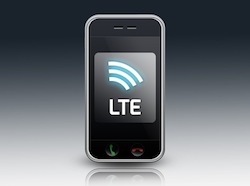Carrier aggregation might be a long way off in Europe, but as some markets begin to mature and operators start looking to acquire more blocks of spectrum for their 4G LTE networks, efficient spectrum utilisation will soon be coming into vogue in Western Europe.
North America, often a model for European operators to follow, is finally making progress with LTE-Advanced.
This week, Sprint awarded contracts to Alcatel-Lucent, Nokia Solutions and Networks (NSN) and Samsung Mobile to help with its new Time Division Duplex-LTE (TDD-LTE) and Fixed Division Duplex-LTE (FDD-LTE) network deployment, while AT&T has announced that TDD-LTE will be available to its customers from December 2013.
There are several ways for operators to go who are seeking to better utilise the spectrum they have available to them, whether it be the spectrum they won in 4G auctions, refarmed spectrum from legacy 2G/3G networks, unlicensed spectrum or unpaired spectrum, i.e. TDD-LTE or FDD-LTE.
According to Maravedis-Rethink’s research director Caroline Gabriel, unpaired spectrum is the way to go for European operators seeking to better utilise spectrum.
“Unpaired spectrum is certainly a good option for many operators, especially those [who] need to maximise data capacity and have asymmetric traffic patterns, [which] in most cases, [are] more download than upload,” she tells Mobile Europe.
“TDD spectrum is currently largely in high frequencies so is good for capacity but has challenges in terms of indoor penetration and range. It therefore provides a good complement to lower frequency FDD spectrum which can support cost-effective rural access, indoor penetration and voice, for example, the way Sprint will combine ‘Clearwire’s 2.5GHz TDD with its own PCS and iDEN FDD bands.
“Some operators have only unpaired, of course, and many of the disadvantages of that position are reducing, notably the availability of devices, but a combination of FDD/TDD would still seem the ideal situation for maximum spectral efficiency and flexibility.”
Analysys Mason’s Wireless Networks principal analyst Chris Nicoll disagrees that unpaired spectrum is the way to go.
“Carrier aggregation is the way to go for operators looking to better utilise their current spectrum resources. This 3GPP Release 10 feature, which is already in commercial deployment in South Korea and widely tested in nearly a dozen other countries, enables operator with even minor spectrum positions to pool them together to create larger, more valuable spectrum channels,” he says.
The method of carrier aggregation Nicholls speaks of is unique to South Korea, whereby it’s actually dual-carrier aggregation whereby the operator adds two different spectrum bandwidths together to get double the speed, rather than TDD-LTE.
“Unpaired spectrum is typically allocated in larger blocks. In 2011, Belgium awarded 45MHz of unpaired 2.6GHz spectrum, while more recently in the UK, BT won 20MHz and Vodafone won 25MHz of 2.6GHz spectrum. Unpaired spectrum can be used more easily to construct mobile broadband networks given the technology is very flexible in how the spectrum is allocated, i.e. uplink ratio versus downlink. To maximise download speed, more of the time blocks can be allocated to download rather than upload, for instance,” explains Nicholls.
European operator Orange says it is considering all different methods for utilising spectrum more efficiently, but cost-efficiency means that unpaired spectrum is not always the preferred method, depending on the country.
“In some Orange countries we have unpaired spectrum. It offers benefits when considering asymmetric broadband traffic but also suffers more from technical interference issues that create operational complexity. We consider unpaired and paired spectrum as complements,” Steve Blythe, Director of Spectrum Strategy for Orange tells Mobile Europe.
“In a number of Orange country operations we have already started refarming spectrum as and when the utilisation of the spectrum used by legacy technologies has declined sufficiently.
“It is clear that virtual carriers that span different frequency bands will be required [in the future]. Orange is considering the deployment of techniques [such as] carrier aggregation, both intra-band and inter-band, when it becomes commercially available in 2015-2016, [which] will be useful in creating the large virtual carriers that will be required to deliver the maximum data rates.”
In the meantime, Orange is currently upgrading its cell sites to become 6-sector-sites as well as deploying small cells and Multiple Input Multiple Output (MIMO) technology.
While Nokia Solutions and Networks supports carrier aggregation and load balancing across frequencies, the vendor is also quite keen on refarming existing spectrum, such as old GSM 850MHz, 900 MHz, 1800 MHz, 1900 MHz and 2100 Hz spectrum from GSM to 3G and LTE.
“For all of these [frequencies], we can use the same RF hardware and do refarming with software. This means that the equipment already in the mast top does not need to be touched,” says Kai Sahala, Head of Mobile Broadband Marketing at NSN.
“In order to make refarming efficient, it is essential that the technologies can be implemented in the narrowest spectrum possible. We can make HSPA fit in the most narrow spectrum, 4.2 MHz, with no throughput degradation, or even 3.8 MHz, with no changes to devices nor the network hardware. This translates to making 3G HSPA possible for frequencies where it would not fit with the traditional 5MHz spectrum allocation.
“In LTE, [our] Smart Scheduler [product] makes better use of existing spectrum by utilising frequency selective scheduling methods – adapting to changing radio conditions. [Beamforming] is also possible using a base station site solution such as Active Antennas. This means that from existing sites, with the same amount of spectrum used, you can get 70 percent increased capacity by creating and managing additional beams.”


